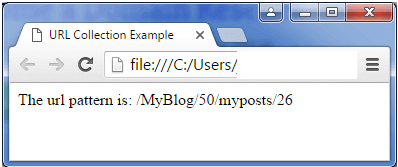Backbone.js集合url方法用于创建集合的实例并显示资源所在的位置。
句法:
collection.url()让我们以一个示例来部署url方法。
请参阅以下示例:
<!DOCTYPE html>
<head>
<title>URL Collection Example</title>
<script src="https://code.jquery.com/jquery-2.1.3.min.js" type="text/javascript"></script>
<script src="https://cdnjs.cloudflare.com/ajax/libs/underscore.js/1.8.2/underscore-min.js" type="text/javascript"></script>
<script src="https://cdnjs.cloudflare.com/ajax/libs/backbone.js/1.1.2/backbone-min.js" type="text/javascript"></script>
</head>
<body>
<script type="text/javascript">
var MyModel = Backbone.Model.extend({}); ////'MyModel' is a model name
//The 'MyCollection' is an instance of the collection
var MyCollection = Backbone.Collection.extend({
model: MyModel //The model 'MyModel' is specified by overriding the "model" property
});
//The model "MyBlog" contains default values for 'user' and 'myposts' attributes
var MyBlog = Backbone.Model.extend({
defaults: {
user: null, myposts: []
}, initialize: function () {
var myval = this;
//Model 'MyModel' gets the 'user' and 'myposts' from the model 'MyBlog' by referring to the current object
this.MyModel = new MyModel(this.get('user'));
this.posts = new MyCollection(this.get('myposts'));
this.posts.url = function () {
return myval.url() + '/myposts';
};
}, //It enables the url() function by using the id attribute to generate the URL as "/MyBlog/50/myposts/26"
urlRoot: '/MyBlog/'
});
var attributes = {
id: 50, myposts:[{id: 26}]
}
//The model "MyBlog" will access the attributes and display the url using 'url()' function
val = new MyBlog(attributes);
val.posts.each(function (MyModel) {
document.write("The url pattern is: ", MyModel.url());
});
</script>
</body>
</html>输出:
将以上代码保存在url.html文件中,然后在新的浏览器中打开该文件。

 srcmini
srcmini
评论前必须登录!
注册